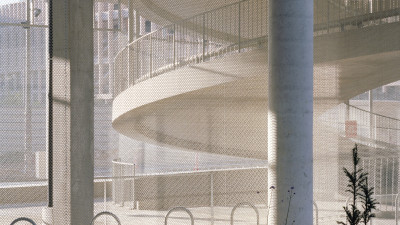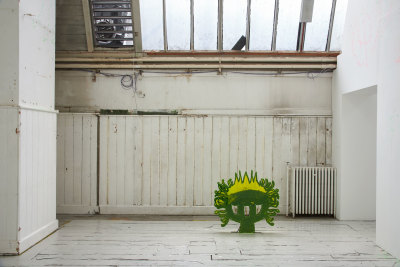The month in architecture
The month in architecture
Everything you need to know that happened in February
By Helena Cuss
Published 1 March 2016
Five architectural things you need to know this month – from big stories to top new projects and the latest prizes.
-
Bjarke Ingels to design 2016 Serpentine Pavilion
The Danish architect’s firm BIG has been chosen to design the 16th pavilion, which is erected each summer in West London’s Kensington Gardens. Initial images released this month reveal a curved wall constructed from fibreglass frames; in a statement BIG described “a structure that is free-form yet rigorous, modular yet sculptural, both transparent and opaque, both solid box and blob.”In a first for the programme, the central pavilion will be joined by four smaller architectural “follies”, to be designed by Nigerian architect Kunlé Adeyemi, Berlin studio Barkow Leibinger, Hungarian-born Yona Friedman and British architect Asif Khan. The smaller structures are intended as a tribute to the nearby 18th-century Queen Caroline’s Temple, a summer house built in 1734 by William Kent. They also mark the end of Julia Peyton-Jones’ directorship of the Serpentine. She is retiring this summer after 25 years.
-

Serpentine Pavilion 2016 designed by Bjarke Ingels Group (BIG); Design render
© Bjarke Ingels Group (BIG)
-

Serpentine Summer House 2016 designed by Kunlé Adeyemi - NLÉ; Design render

Serpentine Summer House 2016 designed by Barkow Leibinger; Design render

Serpentine Summer House 2016 designed by Yona Friedman; Design render

Serpentine Summer House 2016 designed by Asif Khan; Architectural model
-
Garden Bridge controversy continues
Arguments over London’s proposed Garden Bridge look set to continue, with both the London Assembly and RIBA President Jane Duncan asking TfL to halt funding, pending interrogations about the procurement process. The bridge has already drawn criticism from all corners: originally intended to be completely privately funded, the ever-rising costs (from £60m in 2013 to £175 in 2016) has led Boris Johnson to pledge at least £40m public funding.In other bridge-related news, architecture studio Farrells and engineers Buro Happold have won Best Conceptual Project at the London Planning Awards for their proposal of a series of 6 bridges across the Thames in the east London area, which they believe would stimulate development on either side. Of the 34 bridges currently spanning the river, only one of these is located east of the London’s famous Tower Bridge. Founder Terry Farrell has proposed that enough land for 47,000 new homes and 10,000 new jobs could be opened up by the scheme, and has identified the need for east London bridges as a key factor in the capital’s housing crisis.
-

Garden Bridge
© Arup
-
Venice Biennale architects and theme announced
Architectural giants such as Herzog & de Meuron, Norman Foster RA, Renzo Piano, Rem Koolhaas, Richard Rogers RA, Shigeru Ban, Kengo Kuma and Wang Shu, and David Chipperfield RA are all to contribute to this year’s Venice Architecture Biennale. Curator Alejandro Aravena hopes that his theme, Reporting from the Front, will encourage architects to offer new perspectives on global issues such as crime, sanitation, housing shortage, traffic, waste, migration and pollution. As well as the 61 national pavilions, London’s V&A Museum will be delivering a special exhibition called A World of Fragile Parts in collaboration with Ordinary Architecture, and LSE professor Ricky Burdett will curate a pavilion examining the relationship between public and private space.Explore the full list of architects exhibiting at the Biennale.
-
Brighton tower tops Guinness World Record
The British Airways i360 in England’s famous seaside resort of Brighton, an observation tower, has been awarded the Guinness World Record for the most slender tower in the world, with a height on 161.75m and a width of just 3.9m. Currently under construction, the spire, around which travels an aerodynamic pod accommodating up to 200 people, has been designed by Marks Barfield, the architects of the London Eye, very much in the same spirit of that now-famous landmark. In a statement, the architects said, “The London Eye has been an extraordinary success. It seems people enjoy vantage points that provide unique views, fresh aspects, new horizons. The British Airways i360 will deliver a similar experience – entertaining, informing, exciting and inspiring.”
-

Visual Air
© Mark Barfield Architects
-
Assemble to restore Schwitters barn
When Storm Desmond whipped through north-east England before Christmas, it took with it the roof and end wall of a little-known but significant architectural installation, by prominent 20th-century DADA artist Kurt Schwitters. The Merzbarn in Cumbria was created as a reconstruction of the original in Hanover, after Schwitters fled Nazi Germany as a “degenerate artist”. It provides an immersive experience of the avant-garde artistic movement, and is considered by many to be an essential part of the canon of British modernist architecture. Unfinished at the time of his death in 1948, Schwitters had planned for it to be “the greatest sculpture of my life.”After appeals to Nicholas Serota and the Arts Council to help with the emergency repairs yielded little results, site-owners Littoral Arts Trust have begun talks with collective Assemble about regenerating the building. The Future of the Merzbarn project would create a new arts centre and museum about the pioneering artist, to open in 2019.










